Content strategy by generation: 6 insights from our surveys of 22,000 students
When we think about the students pursuing higher education today, the term “digital natives” comes to mind. Though many use this term to describe all students, there are nuances to how Millennials, Gen Z, and Gen P—the generation whose high school experience was heavily influenced by the pandemic—interact with colleges and universities online. Understanding these distinctions and accounting for them in your communication strategy can greatly increase your chances of connecting with each generation of students.
EAB regularly conducts research with prospective and current students, from high school students, to first-year undergrads to adult learners, on how they conduct their higher education search. We also include parents and counselors in our research to better understand their perspective on higher education and how they are influencing prospective students. To help your enrollment team connect online with today’s students, I want to share 6 key insights from our latest surveys of more than 22,000 students, covering how Millennials, Gen Z, and a newly identified subset of students, Gen P, interact with colleges online.
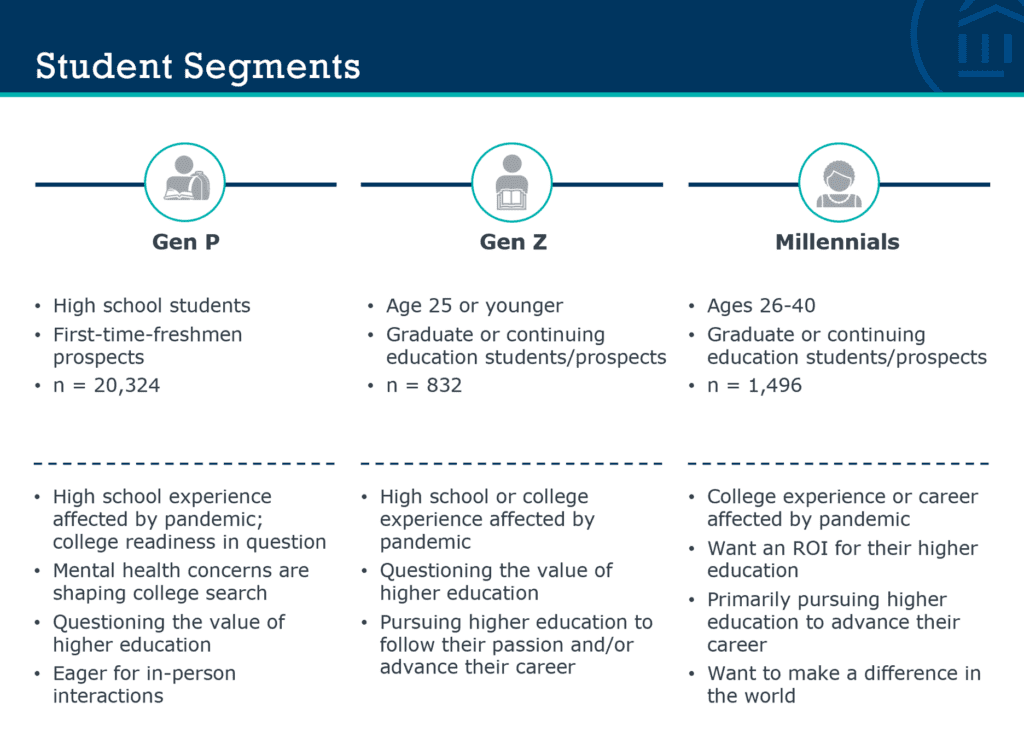
Insight 1: Web-based sources are the primary resources for Gen Z and Millennials
The website has long been one of the most valuable assets for a school to connect with prospective students. And while most students, regardless of generation, are using web-based sources to gather information about schools, they are the primary sources for Millennials and Gen Z and a secondary resources for Gen P.
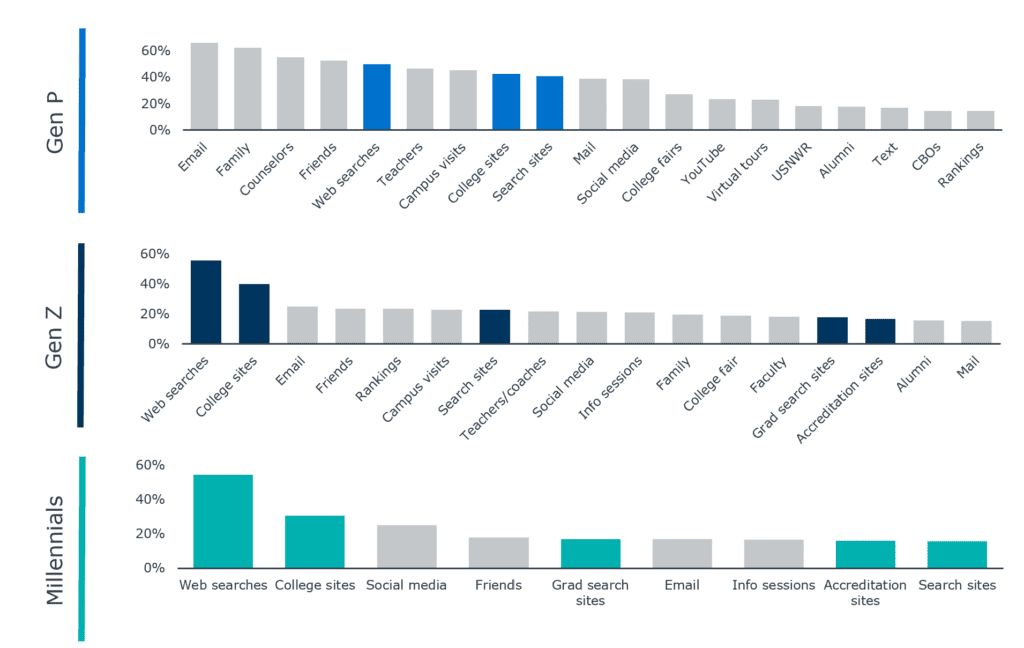
Our research shows that Millennials and Gen Z are also using college and grad search sites as well as accreditation websites as resources. While not the primary sources of information for Gen P, web searches are still used by over half of these students, and specific college websites and college search sites are used by a significant percentage as well.
We’ve also noticed a trend of students increasingly relying on web searches to gather information, rather than going directly to the .edu. User testing conducted with high school students revealed they are reducing multiple clicks to one click by Googling questions instead of going to school websites. It’s a good time for institutions to make certain their websites are user-friendly and contain the information students most want to see. Proper SEO/SEM implementation and management ensure that the information you want students to see is at the top of their search results.
Insight 2: Gen Z is passion-focused
Gen Z desires more than a degree; they are seeking an educational experience that will help them follow their passions. Whether through specialized academic programs, enriching extracurricular activities, or unique learning opportunities, clearly articulating support mechanisms for aligning education with individual interests is paramount. One of our survey questions, represented in the graph below, shows that over 40% of Gen Z participants indicated that they want to further their education to advance their career and/or pursue a passion. This is a significant increase over the 25% of millennials who report passion-pursuant behavior.
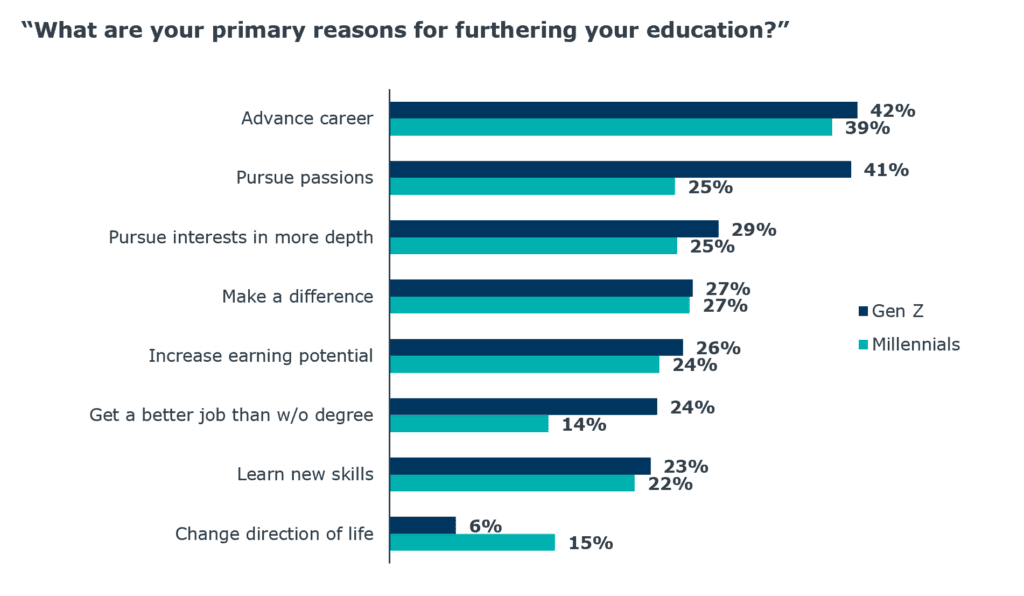
To convey the value of a degree, schools need to move beyond general statements about academic excellence or skill-building. We know that Gen Z students want to build lives that reflect their values and do good for the world, but they are also concerned about debt, financial mobility, and social mobility. College websites should emphasize concrete evidence, such as alumni success stories and employment rates, to help highlight what students value most By presenting clear and verifiable outcomes, schools can assure Gen Z students that their investment in higher education is a practical and informed decision, leading to meaningful career opportunities and financial/social mobility. This transparent communication caters to a generation that values both purpose and practicality in their educational pursuits.
Insight 3: Gen P is using “traditional” sources more frequently
Unlike Millennials and older Gen Z students, Gen P students may rely more on “traditional” sources, such as email and mail in their education search. Despite assumptions that these sources may have fallen out of favor with students, these findings show otherwise.
Sources Used – Role of Email and Mail
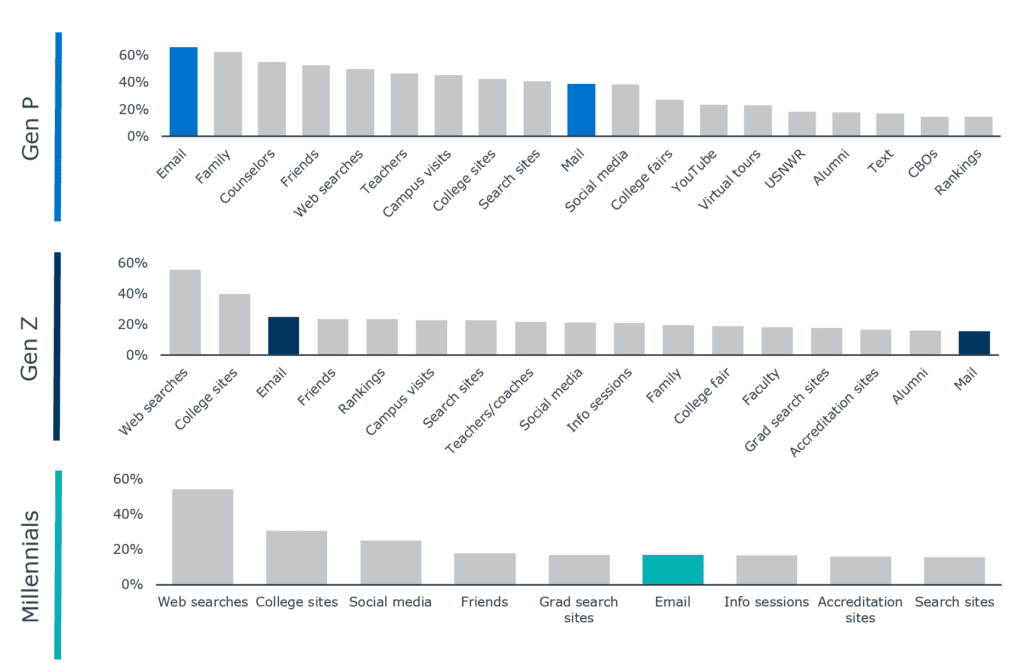
And we can’t forget about the pass-along factor that exists with mail. Parents and family members can see a piece of mail from a school without the student having to be proactive about sharing.
Report Shows Pandemic Negatively Impacted “Gen P’s” Interest in College
Insight 4: Gen P and Gen Z are more reliant on personal sources than Millennials
While Gen P and Gen Z are using more sources, generally, than Millennials, they are also more likely to use personal sources like family, friends, counselors, teachers, and alumni than Millennials. These findings highlight the importance of connecting with the people who are influencing prospective students in their search.
Sources Used – Role of Personal Contacts
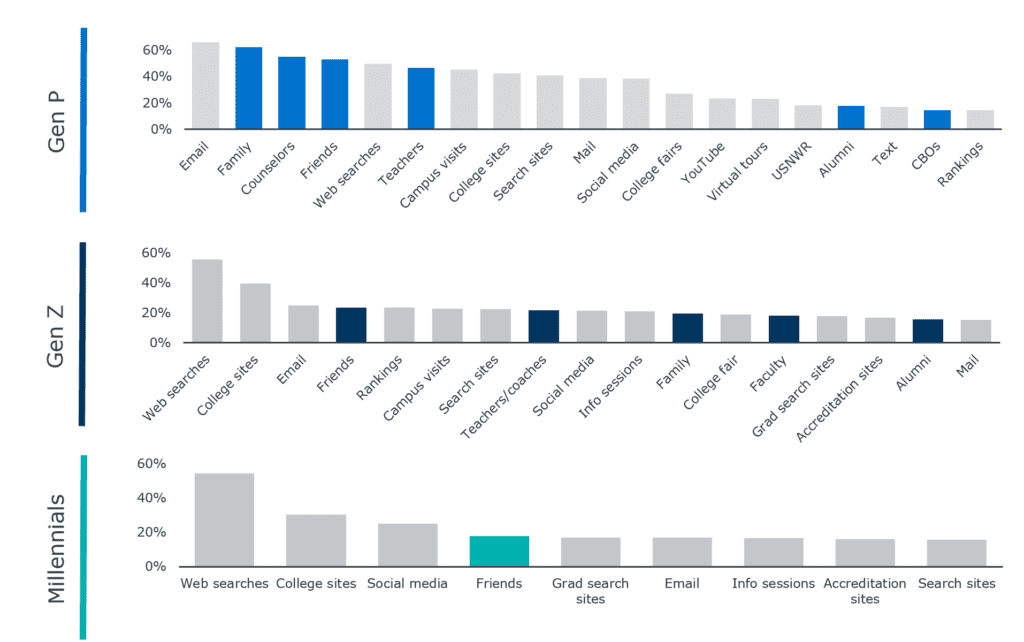
A robust communication plan with parents and other family members is essential, and many of our partners utilize parent marketing tactics to connect with them. Beyond parents/families, high school counselors can also be one of the best ways to connect with Gen Z and Gen P. In 2023, we conducted a survey in partnership with the National Association of College Admission Counseling (NACAC). Findings from 2,800 counselors revealed they want proactive communications from schools, including high school visits, email, and face-to-face events.
Insight 5: YouTube and Instagram are ubiquitous
For US Gen Z adults and millennials, social media is a way of life. So to reach each generation with the right message, and in the right place, we need to understand their individual social media platform preferences.
We asked participants about their social media usage to better understand their engagement. The graph below displays sites that are being used by 20% or more of participants.
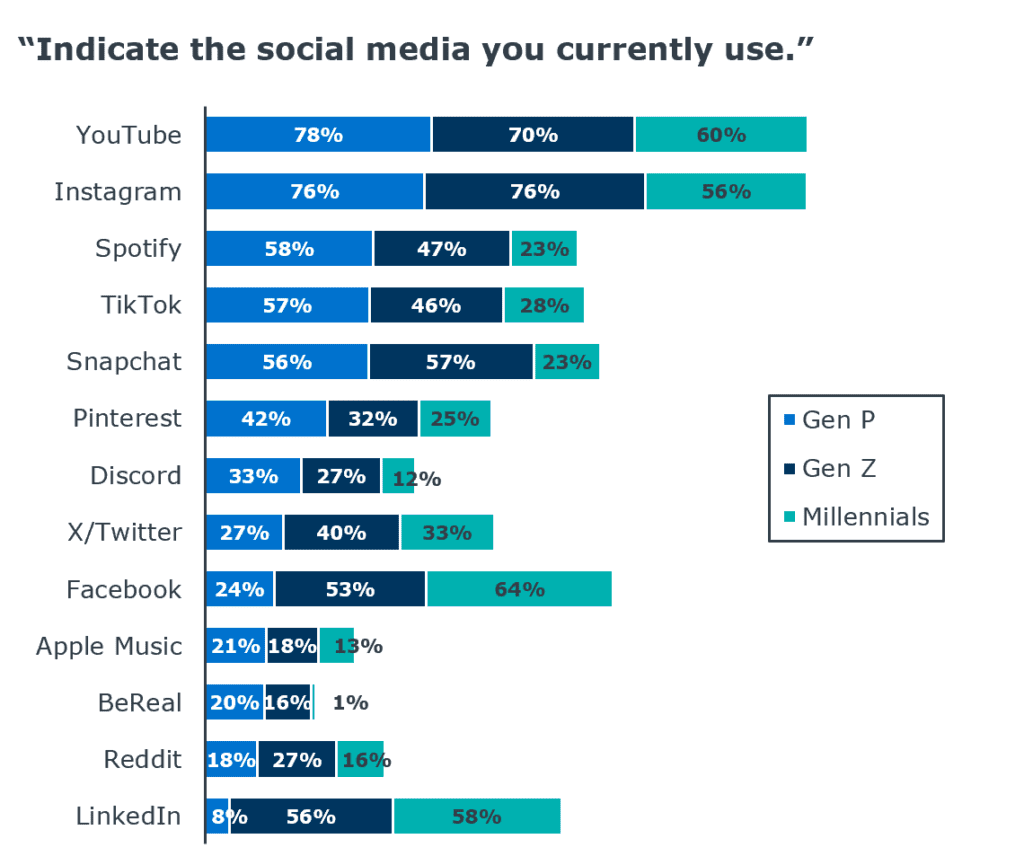
When crafting your social media strategy, you can prioritize those channels that your prospective students use. YouTube and Instagram are used by most students from each segment. YouTube and Instagram are the top social media for Gen P and Gen Z, while Facebook and YouTube are most used by Millennials.
Top Social Media by Generation
Gen P
- YouTube
- Spotify
- TikTok
- Snapchat
Gen Z
- YouTube
- Snapchat
Millennials
- YouTube
- X/Twitter
Insight 6: Good web design matters, no matter the generation
A critical point of consensus among all generations is that college websites must have outstanding web design. This includes user-friendly navigation, responsive layouts, fast load times, and a visually appealing interface. An attractive website is more likely to hold the attention of prospective students and create a positive impression of the institution.
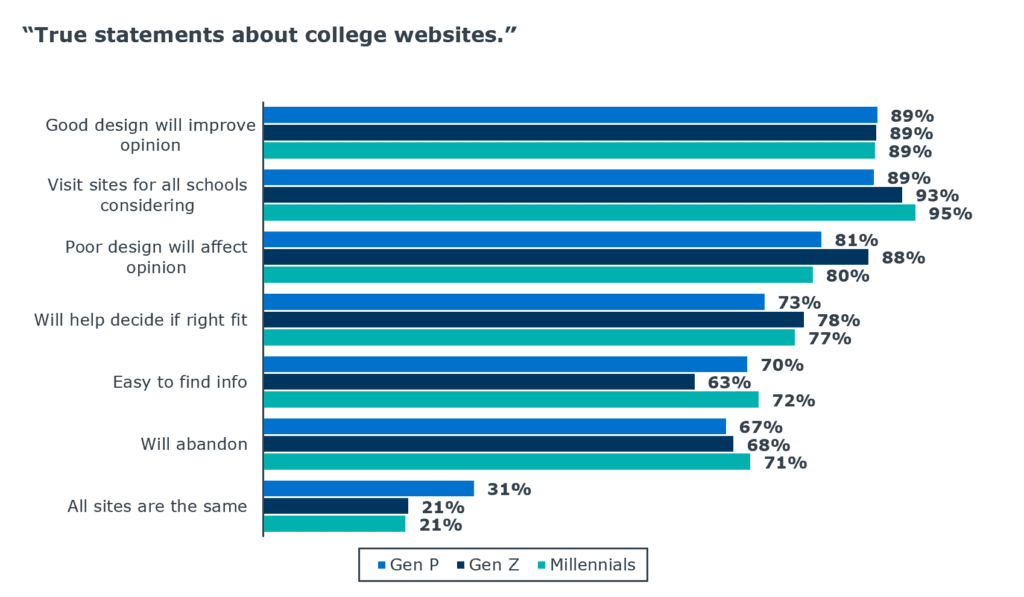
What all three generations of students agree on:
- A well-designed website will improve their opinions about a school, and a poorly designed website will do the opposite.
- They will visit the websites for every school they are considering.
- A school’s website is a good channel to use when determining if a school is a good fit.
- Students will abandon a website if it is not user-friendly.
Students expect school websites to provide a wealth of information, including program details, admission requirements, and financial aid options. They value a seamless online experience, where they can explore academic offerings and other campus-related information hassle-free.
It is noteworthy that only a small percentage of students indicated all websites are the same. This highlights that there is an expectation for a unique and well-designed, user-friendly web experience.

More Blogs

What enrollment leaders can learn from Alabama’s statewide direct admissions program

Is your yield rate okay?
